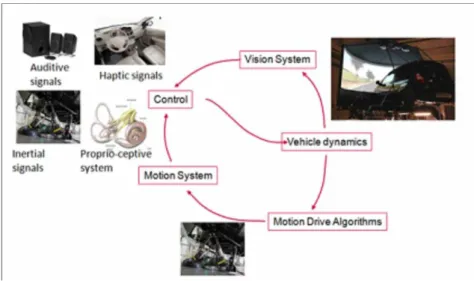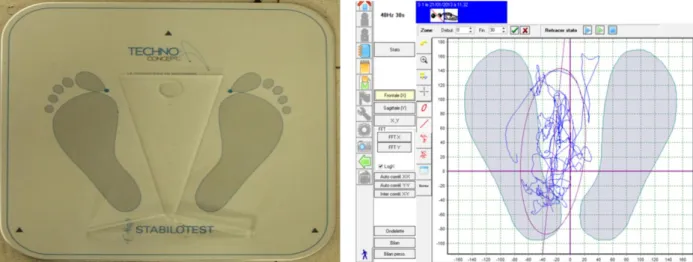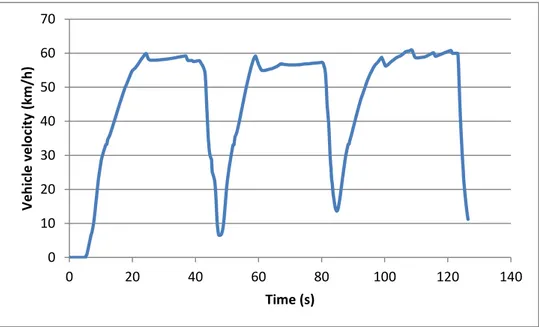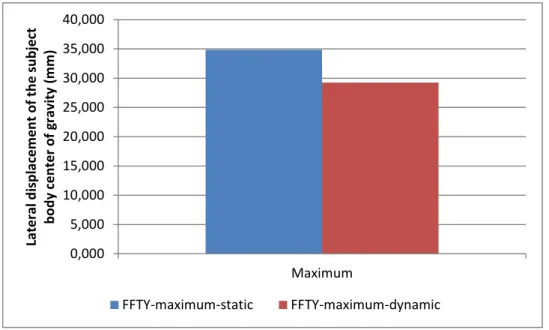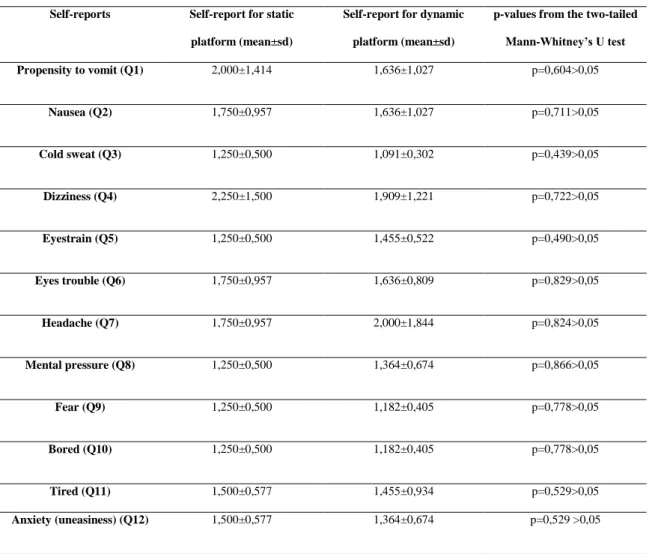Science Arts & Métiers (SAM)
is an open access repository that collects the work of Arts et Métiers Institute of Technology researchers and makes it freely available over the web where possible.
This is an author-deposited version published in: https://sam.ensam.eu Handle ID: .http://hdl.handle.net/10985/7217
To cite this version :
Baris AYKENT, Frédéric MERIENNE, Damien PAILLOT, Andras KEMENY - The contribution of closed loop tracking control of motion platform on laterally induced postural instability of the drivers at SAAM dynamic simulator - In: CONFERE 2013, France, 2013-07-04 - CONFERE 2013 - 2013
CONFERE 2013 BIARRITZ
4 – 5 JUILLET 2013,BIARRITZ
THE CONTRIBUTION OF CLOSED LOOP TRACKING
CONTROL OF MOTION PLATFORM ON LATERALLY
INDUCED POSTURAL INSTABILITY OF THE
DRIVERS AT SAAM DYNAMIC SIMULATOR
Baris Aykent1,a, Frédéric Meriennea , Damien Paillota, Andras Kemenya,b
a
Arts et Métiers ParisTech, CNRS, Le2i
Institut Image, 2 rue T. Dumorey, 71100 Chalon-sur-Saône, France
1
Corresponding Author, +33 (0) 385909865, b.aykent@gmail.com
b
Technical Centre for Simulation, RENAULT Guyancourt, France
ABSTRACT
This paper explains the effect of a motion platform closed loop control comparing to the static condition for driving simulators on postural instability. The postural instabilities of the participants (N=18, 15 male and 3 female subjects) were measured as lateral displacements of subject body centre of pressure (YCP ) just before and after each driving session via a balance platform. After having
completed the experiments, the two-tailed Mann-Whitney U test was applied to analyze the objective data for merely the post-exposure cases. The objective data analysis revealed that the YCP for the
dynamic case indicated a significant lower value than the static situation (U(18), p < 0,0001). It can be concluded that the closed loop tracking control of the hexapod platform of the driving simulator (dynamic platform condition) decreased significantly the lateral postural stability compared to the static operation condition. However the two-tailed Mann-Whitney U test showed that no significant difference was obtained between the two conditions in terms of psychophysical perception.
Keywords: postural stability, hexapod platform, closed loop control, dynamic driving simulator, virtual reality
1 INTRODUCTION
There are so many implications to be fulfilled in the area of driving simulators. The most important of them is to sustain the reality for the represented dynamics in multi-level (vehicle dynamics, platform dynamics, head and musculoskeletal dynamics of the subjects). The major leading problems are the restricted workspace of the driving simulator and whether a motion base exists integrated with the driving simulator. The first driving simulators were fixed-base and the simulation was principally performed by the visual stimulus [Stratulat, 2010, Bertin, 2004] to create the self-motion perception. This perception is based upon the principle of visual scene flow on the retina referring to the velocity, direction of the motion and the relative distances [Bremmer, 1999].
For the static platformed driving simulators, illusory self-motion „vection‟ often occurs because the driver is stationary and the visual scenario is mobile [Lepecq, 2006, Kolasinski, 1995, Berthoz , 1975, DiZio, 1989, Draper, 1998, Hettinger, 1990, Hettinger, 1992, Hettinger, 2002, McCauley, 1992]. The incompetencies in the domain of driving simulators, whether they are fixed or motion base simulators, might make the motion sickness an inevitable topic for the development of the researches undertaken.
The methods of evaluating and measuring the motion sickness might diversify depending on the type of the research. In general, there are two ways to assess and measure the sickness level as objective and subjective methods. Objective methods refer to the direct measurements of head (vestibular) level, postural, vehicle and motion platform level dynamics. Out of the objective data measurements, vestibular and postural level data acquisitions refer to the musculoskeletal dynamics of the participants. The subjective methods imply the evaluation via Simulator Sickness Questionnaires (SSQ). Driving simulation sickness was assessed between dynamic and static simulators in some studies [Curry, 2002, Watson, 2000]. A relation was made between the illness and the head movements of the pilot in absence and presence of the motion base [Kennedy, 1987]. A significant reduction in motion sickness occurs when an individual adopts a postural position was expressed in [Reason, 1975]. “Postural instability theory” was introduced also to define relations between perception and the control of action by [Riccio, 1991]. This approach considers the behaviour of the individual as fundamental in motion sickness etiology. The postural instability theory of motion sickness presumes that motion sickness is resulted and estimated by instabilities in control of the supine. This was attributed to constraints in motion of the head.Relations were declared between head motions and motion sickness through the mechanisms of Coriolis (with actual inertial cues: motion platform) and pseudo-Coriolis (through visual cues) stimulation [Kennedy, 1987, Reason, 1975]. Coriolis stimulation occurs when the head is tilted out of the axis of rotation during actual body rotation [Dichgans, 1973, DiZio, 1988, DiZio, 1989, Guedry, 1964, Guedry, 1961]. Pseudo-Coriolis stimulation occurs when the head is tilted as perceived self-rotation that is induced by visual stimuli [DiZio, 1989].
In a moving-base simulator, the subjects‟ head movements were similar to those in the actual vehicle according to those studies in [Kennedy, 1987, Dichgans, 1973, DiZio, 1988, DiZio, 1989, Guedry, 1964, Guedry, 1961] where the head movements in fixed-base simulators were often in conflict with the inertial stimulus, which increased the discrepancy of the simulation [DiZio, 1989].
Another research on the motion platform effects revealed that using active platform driving simulator yielded more realistic visuo-vestibular cues, in other words less conflict, at the lateral dynamics for the passenger condition when the simulator was operated as autopilot mode [Aykent, 2013].
However, there have been not so many publications contributed on the subjects‟ postural stability in the domain of driving simulation. This paper aims to investigate the effect of motion platform control with respect to static condition on subjective self-report and on bodys‟ centre of pressure (CP) lateral displacements of the drivers at the dynamic driving simulator.
This research work was accomplished under the static and dynamic operations of the SAAM (Simulateur Automobile Arts et Métiers) driving simulator (Figure 1). The dynamic driving simulator SAAM involves a 6 DOF (degree of freedom) motion system (Figure 1). The details can be found in [Aykent, 2012a, Aykent, 2012b, Aykent, 2013]. It is exploited on a RENAULT Twingo 2 cabin with the original control instruments (gas, brake pedals, steering wheel). The visual system is realized by a 150° cylindrical view (Figure 1). Along with the driving cabin of the simulator, the multi-level measuring techniques are available: vehicle model and motion platform dynamics levels real-time data acquisition via SCANeRstudio driving simulation software, vestibular level dynamics real-time data acquisition via XSens motion tracker, arm and neck muscles dynamics measurement via Biopac EMG
(electromyography) device [Aykent, 2012a, Aykent, 2012b], human‟s centre of pressure displacements measuring equipment Technoconcept to check postural stability.
Figure 1. Structure of the SAAM driving simulator
Figure 1 illustrates the SAAM moving-base driving simulator. It could be operated as with static or dynamic platform by switching the “motion platform” module off and on respectively. As seen in the figure, in general there are three dynamical systems of the SAAM driving simulator. They are vehicle dynamics, motion platform dynamics (motion system) and human vestibular (proprioceptive system) and postural dynamics. By manipulating or controlling the vehicle dynamics that moves in the vision system and the motion platform dynamics via motion drive algorithms, their effect on human vestibular dynamics or postural instability can be compared.
The motion cueing algorithm used for the dynamic platform case is the coupling of [Aykent , 2012a, Aykent, 2012b]. The motion cueing algorithm was included in the SCANeR studio driving simulation software via dll plugin in order to accomplish the real-time driving experiments with the participations of the subjects.
1.1 Scientific issue
The driving simulator is a virtual reality toll that necessitates multi-sensory cues (visual, inertial, vestibular, haptic, acoustic, vibration). The participants give reaction to those cues generally by their head movements and by their musculoskeletal systems which forms the proprioception. The subject‟s reaction in terms of musculoskeletal systems contains neuromuscular dynamics behaviours of them during the driving simulation experiments, postural instability and head movements.
Postural instability deals with the biomechanical response dynamics of the participants which is related to the balance of the skeleton. From the measurement by using balance platforms, the surface change of the subject body CP (center of pressure) can be analyzed for pre and post-experimental phases. The change between the pre- and post-experiments or the comparisons of post-exposures can allow us to make conclusion whether the participants‟ postural stabilities decrease after the simulations. Another method to evaluate the subjects‟ postural stability is to analyze the body CP for the longitudinal and the lateral displacements. This is managed by using FFT (Fast Fourier Transform) method in PostureWin software of Technoconcept.
It is widely accepted that if there is a sensory cue conflict, it could provoke simulator sickness [Oman, 1982].
This article deals with the postural instability data and subjective rating data of subjects in driving simulator with an active controlled and a passive (static) motion platform for the experimental setups. The emphasis is done on the instantaneous change of the road curvatures and the participants‟ responses to those regarding postural and perceptual responses.
Hypotheses to be tested are:
- If the motion platform is activated with a closed loop control of the hexapod, how does the laterally induced postural stability (objective measure) change comparing to the static platform situation?
- If the motion platform is activated with a closed loop control of the hexapod, how does the perception (subjective measure) change comparing to the static platform situation?
2 MATERIALS AND METHODS
Postural stability of the subjects was identified by using a stabilotest of Technoconcept (Figure 2). The measurements were performed as eyes open, after the driving sessions at the simulator. The data acquisition was done for 30 seconds at 40 Hz. Fast Fourier Transforms (FFTs) of the lateral displacements of the centre of pressure (CP) for the participants‟ bodies were registered for the dynamic and static platform conditions. The participants were asked to get on the postural stability platform just before and after the completion of each driving session in order to investigate the effect of closed loop tracking control of the motion platform comparing to the static case. In this study, we reported the post-experiment measures of the body balances for the subjects.
Figure 2. Hardware and software tools for the postural instability measurement
3 SUBJECTS
The experimental phases were accomplished to analyze the effect of the motion cueing algorithm with respect to the static platform condition. 18 subjects (N=18, 15 male and 3 female subjects, aged mean: 31.19 years, SD: 7.92 years and with driving license mean: 12.63 years, SD: 7.29 years. SD: standard deviation) took place in the experiments of these two cases.
4 PROTOCOL
The two conditions (passive and active platforms) were driven by the same subjects (N=18) for the specific scenario on the simulator as in real-time. Figure 3 depicts the vehicle velocity whereas the Figure 4 illustrates the steering wheel angle in degrees. The whole experimental phase was accomplished with a constant velocity of 60 km/h in 126 seconds.
Figure 3. Vehicle velocity (km/h)
Figure 4. Steering wheel angle (°)
5 DATA ANALYSIS
Two-tailed Mann-Whitney U- tests were used to evaluate the effect of having a dynamic closed loop control of the hexapod platform on lateral body displacements (YCP) of the subjects as an objective
metrics and also on self-reports of the psychophysical perception as a subjective metrics (CP: center of pressure). 0 10 20 30 40 50 60 70 0 20 40 60 80 100 120 140 Veh ic le v e lo ci ty (k m /h ) Time (s) -400 -300 -200 -100 0 100 200 300 0 20 40 60 80 100 120 140 Ste e ri n g wh e e l an gl e ( °) Time (s)
6 RESULTS AND DISCUSSION 6.1 Objective data
Figure 5. Comparison of mean lateral displacement (YCP) of the participants’ bodies: error bars indicate the standard deviation for each case.
Figure 5 illustrates the comparison between the passive and active closed loop controlled platforms‟ effects on human lateral postural stability that joined in the experiments. According to this, the mean and the standard deviation of the lateral postural instability were decreased by using the active hexapod platform from 0,731±2,365mm to 0,638±2,078mm (see also Table 1)
Figure 6. Comparison of maximum lateral displacement (YCP) of the participants’ bodies
Figure 6 expresses the comparison between the passive and active closed loop controlled platforms‟ effects on human maximum lateral postural instability that participated in the experiments. According
-2,000 -1,000 0,000 1,000 2,000 3,000 4,000 Mean Late ral d isp lac e m e n t o f th e su b jec t b o d y ce n te r o f g rav ity (m m ) FFT Y -mean-static FFT Y -mean-dynamic 0,000 5,000 10,000 15,000 20,000 25,000 30,000 35,000 40,000 Maximum Late ral d isp lac e m e n t o f th e su b jec t b o d y ce n te r o f g rav ity (m m ) FFTY-maximum-static FFTY-maximum-dynamic
to this, the maximum lateral postural instability was decreased by using the active hexapod platform from 34,842 mm to 29,259 mm (see also Table 1).
Table 1. Summary statistics for the dynamic and the static platform cases
Variable Minimum Maximum Mean±SD
YCP of the subject body at
static platform (mm) 0,000 34,842 0,731±2,365
YCP of the subject body at
dynamic platform (mm) 0,000 29,259 0,638±2,078
6.2 Subjective data
In order to assess the driving simulator tests subjectively on behalf of “perception due to psychophysics”, a simulator sickness and psychophysical perception questionnaire which consists of twelve questions (grading 1: too little 10: too strong) was given to each participant to have a subjective measure of the driving simulation.
Figure 7. Subjective data comparison between the dynamic closed loop control of the hexapod platform and the static condition
Figure 7 explains the comparison between the passive and active closed loop controlled platforms‟ effects on subjective self-reports who drove in the experiments. According to this, there was no significant difference between passive and active platform cases (see also Table 2, all p>0,05).
1 2 3 4 5 6 7 8 9 10 Q1 Q2 Q3 Q4 Q5 Q6 Q7 Q8 Q9 Q10 Q11 Q12 Su b jec tiv e d ata
psychophysical perception for dynamic platform psychophysical perception for static platform
Table 2. Self-report results and verifying the differences significance for the dynamic and the static platform cases
Self-reports Self-report for static
platform (mean±sd)
Self-report for dynamic
platform (mean±sd)
p-values from the two-tailed
Mann-Whitney’s U test Propensity to vomit (Q1) 2,000±1,414 1,636±1,027 p=0,604>0,05 Nausea (Q2) 1,750±0,957 1,636±1,027 p=0,711>0,05 Cold sweat (Q3) 1,250±0,500 1,091±0,302 p=0,439>0,05 Dizziness (Q4) 2,250±1,500 1,909±1,221 p=0,722>0,05 Eyestrain (Q5) 1,250±0,500 1,455±0,522 p=0,490>0,05 Eyes trouble (Q6) 1,750±0,957 1,636±0,809 p=0,829>0,05 Headache (Q7) 1,750±0,957 2,000±1,844 p=0,824>0,05 Mental pressure (Q8) 1,250±0,500 1,364±0,674 p=0,866>0,05 Fear (Q9) 1,250±0,500 1,182±0,405 p=0,778>0,05 Bored (Q10) 1,250±0,500 1,182±0,405 p=0,778>0,05 Tired (Q11) 1,500±0,577 1,455±0,934 p=0,529>0,05 Anxiety (uneasiness) (Q12) 1,500±0,577 1,364±0,674 p=0,529 >0,05
A hypothesis was evaluated about postural instability precedes the onset of motion sickness [Stoffregen, 1998]. Subjects who stood in a “moving room” were subjected to nearly global oscillating optical flow. In the experimental condition, the optical oscillations were a complex sum-of-sines between 0.1 and 0.3 Hz, with an excursion of 1.8 cm. This optical motion was of such low frequency and magnitude that it was sometimes not noticed by participants. However, in two experiments, exposure to the moving room produced significant increases in self report rating on a standard motion sickness questionnaire. In addition, approximately half of subjects declared motion sickness. Analysis of postural motion during exposure to the moving room depicted increases in postural sway before the onset of subjective motion sickness symptoms. This confirms the prediction of the postural instability theory of motion sickness [Stoffregen, 1998].
An investigation was realized whether postural instability is able to estimate motion sickness and the relations were studied among instability, motion sickness, and vection. 9 men and 4 women (mean age = 19.85 years) were exposed, while standing, to an optical simulation of body sway [Smart, 2002]. Head motion was recorded using a magnetic tracking system. Postural instabilities were observed prior to the onset of motion sickness. Vection was reported by most participants, including all who became ill. A discriminant analysis revealed that parameters of postural motion accurately predicted motion sickness. The results illustrated that postural instability precedes motion sickness and
suggest that measures of postural motion may serve as reliable predictors of motion sickness. Potential applications of this research include the development of on-line diagnostic tools that will allow for the prevention of motion sickness in operational and training settings [Smart, 2002].
Our objective measure findings were similar to those that were revealed by [Smart, 2002] and [Stoffregen, 1998]. As a summary, it can be inferred that the vection provokes the motion sickness. We also found out that self motion induced merely by the visual environment in the passive platform driving simulator condition significantly increased the lateral postural instability comparing to the active platform one. However our subjective self report results did not show any significant differences in terms of static and dynamic platform cases.
7 CONCLUSION AND FUTURE WORK
This study revealed that even the active closed loop tracking control reduced the subjects‟ lateral postural instability (U(18), p<0,0001) , it did not play any significant role on perceptual reports comparing to the static platform case.
For the future work, we are aiming to compare different types of washout algorithms that we have already implemented in the dynamic driving simulator to find out the effects of the subjective assessments, physiological reactions (for example: electromyography (EMG))… etc.
REFERENCES
Aykent, B., Paillot, D., Merienne, F., Kemeny, A., 2012. A LQR Washout Algorithm for a Driving Simulator Equipped with a Hexapod Platform: The Relationship of Neuromuscular Dynamics with the Sensed Illness Rating. CONFERE, 5-6 July 2012, Venice, Italy.
Aykent, B., Paillot, D., Merienne, F., Kemeny, A., 2012. The Influence of the feedback control of the hexapod platform of the SAAM dynamic driving simulator on neuromuscular dynamics of the drivers. Driving Simulation Conference, Paris, France.
Aykent, B., Merienne, F., Paillot, D., Kemeny, A., 2013. Influence of Inertial Stimulus on Visuo- Vestibular Cues Conflict for Lateral Dynamics at Driving Simulators. J Ergonomics ; 3:1-7. Benson, A., J., 1988. Motion Sickness. Medical Aspects of Harsh Environments, Volume 2, pp 1048-1083, United Kingdom.
Berthoz, A. , Pavard, B. , Young, L., 1975. Perception of linear horizontal self-motion induced by peripheral vision (linearvection) basic characteristics and visual-vestibular interactions. Exp Brain Res 23: 471-489
Bertin, R., Berthoz, A., 2004. Visuo-vestibular interaction in the reconstruction of travelled trajectories. Experimental brain research 154: 11-21.
Bremmer, F., Kubischik, M., Pekel, M., Lappe, M. , Hoffmann K.P., 1999. Linear vestibular self- motion signals in monkey medial superior temporal area. Ann N Y Acad Sci 871: 272-281. Curry, R., Artz, B., Cathey, L., Grant, P., Greenberg, J., 2002. Kennedy ssq results: fixed-vs motion- based FORD simulators. Proceedings of DSC: 289-300.
Dichgans, J., Brandt, T., 1973. Optokinetic motion sickness and pseudo-coriolis effects induced by moving visual stimuli. Acta Oto-Laryngologica ; 76, 1-6: 339–348.
DiZio, P., Lackner, J., 1989. Perceived self-motion elicited by postrotary head tilts in a varying gravitoinertial force background. Attention, Perception, & Psychophysics 46: 114-118. Dizio, P., Lackner, J., 1988. The effects of gravitoinertial force level and head movements on post- rotational nystagmus and illusory after-rotation. Experimental Brain Research ; 70, 3: 485–495. Dizio, P., Lackner, J., 1989. Perceived self-motion elicited by postrotary head tilts in a varying gravitoinertial force background. Attention, Perception, & Psychophysics ; 46, 2: 114–118. Draper, M., 1998. The adaptive effects of virtual interfaces: vestibulo-ocular reflex and simulator sickness. University of Washington.
Guedry, F.E., 1964. Visual control of habituation to complex vestibular stimulation in man. Acta oto-laryngologica ; 58, 1-6: 377–389.
Guedry, F.E., Montague, E.K., 1961. Quantitative evaluation of the vestibular coriolis reaction. Aerospace Med ; 32, 6: 487.
Hettinger, L., Riccio, G., 1992. Virtually induced motion sickness in virtual environments. Presence: Teleoperators and Virtual Environments, vol. 1, no. 3: 306–310.
Hettinger, L., 2002. Illusory self-motion in virtual environments. Handbook of virtual environments Design implementation and applications.
Kennedy, R., Berbaum, K., Lilienthal, M., et al., 1987. Guidelines for alleviation of simulator sickness symptomatology. Tech. rep., DTIC Document.
Kolasinski, E.,1995. Simulator sickness in virtual environments. DTIC Document.
Lepecq, J., De Waele, C., Mertz-Josse, S., Teyssèdre, C., Huy, P., Baudonnière, P., Vidal, P., 2006. Galvanic vestibular stimulation modifies vection paths in healthy subjects. J Neurophysiol 95: 3199-3207.
McCauley, M. , Sharkey, T., 1992. Cybersickness- perception of self-motion in virtual environments. Presence: Teleoperators and Virtual Environments 1: 311-318.
Reason, J., Brand, J., 1975. Motion sickness. Academic Press.
Riccio, G., Stoffregen, T., 1991. An ecological theory of motion sickness and postural instability. Ecological psychology :3, 3, 195–240.
Smart, L.,J. Jr., Stoffregen, T., A., Bardy, B.,G., 2002. Visually Induced Motion Sickness Predicted by Postural Instability. Human factors, Postural instability and motion sickness, pp. 1–15.
Stratulat, A., Roussarie, V., Vercher, J., Bourdin, C., 2010. Does tilt/translation ratio affect perception of deceleration in driving simulators? Journal of Vestibular Research 21: 127-139. Stoffregen, T., A., Smart, L., J. Jr., 1998. Postural instability precedes motion sickness. Brain Research Bulletin, Vol. 47, No. 5, pp. 437– 448.
Watson, G., 2000. A Synthesis of Simulator Sickness Studies Conducted in a High-Fidelity Driving Simulator. Proceedings of Driving Simulation Conference: 69-78.
